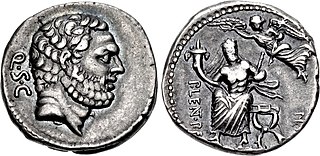
This article concerns the period 49 BC – 40 BC.

This article concerns the period 59 BC – 50 BC.
Year 54 BC was a year of the pre-Julian Roman calendar. At the time, it was known as the Year of the Consulship of Appius and Ahenobarbus. The denomination 54 BC for this year has been used since the early medieval period, when the Anno Domini calendar era became the prevalent method in Europe for naming years.
Gaius Memmius was a Roman politician, orator and poet. He is most famous as the dedicatee of Lucretius' De Rerum Natura, and for his appearances in the poetry of Catullus.

Publius Cornelius Lentulus Spinther was a Roman politician and general. Hailing from the patrician family of the Cornelii, he helped suppress the Catilinarian conspiracy during his term as curule aedile in 63 BC and later served as consul in 57 BC. Denied the opportunity to invade Egypt the following year, he nevertheless won some victories in his province of Cilicia and celebrated a triumph over it in 51 BC.

Caesar's civil war was a civil war during the late Roman Republic between two factions led by Gaius Julius Caesar and Gnaeus Pompeius Magnus (Pompey), respectively. The main cause of the war was political tensions relating to Caesar's place in the republic on his expected return to Rome on the expiration of his governorship in Gaul.

The siege of Massilia, including two naval engagements, was an episode of Caesar's Civil War, fought in 49 BC between forces loyal to the Optimates and a detachment of Caesar's army. The siege was conducted by Gaius Trebonius, one of Caesar's senior legates, while the naval operations were in the capable hands of Decimus Brutus, Caesar's naval expert.
Lucius Domitius Ahenobarbus, consul in 54 BC, was an enemy of Julius Caesar and a strong supporter of the aristocratic party in the late Roman Republic.

The Battle of Ilerda took place in June 49 BC between the forces of Julius Caesar and the Spanish army of Pompey Magnus, led by his legates Lucius Afranius and Marcus Petreius. Unlike many of the other battles of the civil war, this was more a campaign of manoeuvre than actual fighting. It allowed Caesar to eliminate the threat of Pompey's forces in Hispania and face Pompey himself in Greece at the Battle of Pharsalus.
Marcus Petreius was a Roman politician and general. He was a client of Pompey and like Pompey he came from Picenum a region in eastern Italy. He cornered and killed the notorious rebel Catiline at Pistoia.

The siege of Corfinium was the first significant military confrontation of Caesar's Civil War. Undertaken in February 49 BC, it saw the forces of Gaius Julius Caesar's Populares besiege the Italian city of Corfinium, which was held by a force of Optimates under the command of Lucius Domitius Ahenobarbus. The siege lasted only a week, after which the defenders surrendered themselves to Caesar. This bloodless victory was a significant propaganda coup for Caesar and hastened the retreat of the main Optimate force from Italia, leaving the Populares in effective control of the entire peninsula.

The siege of Brundisium was an early military confrontation of Caesar's Civil War. Taking place in March 49 BC, it saw the forces of Gaius Julius Caesar's Populares besiege the Italian city of Brundisium on the coast of the Adriatic Sea which was held by a force of Optimates under the command of Gnaeus Pompeius Magnus. After a series of brief skirmishes, during which Caesar tried to blockade the harbour, Pompey abandoned the city and managed to evacuate his men across the Adriatic to Epirus. Pompey's retreat meant that Caesar had full control over the Italian Peninsula, with no way to pursue Pompey's forces in the east he instead decided to head west to confront the legions Pompey had stationed in Hispania.
The Battle of Tauroento was a naval battle fought off the coast of Tauroento during Caesar's Civil War. Following a successful naval battle outside Massilia, the Caesarian fleet commanded by Decimus Junius Brutus Albinus once again came into conflict with the Massiliot fleet and a Pompeian relief fleet led by Quintus Nasidius on 31 July 49 BC. Despite being significantly outnumbered, the Caesarians prevailed and the Siege of Massilia was able to continue leading to the eventual surrender of the city.
The siege of Curicta was a military confrontation that took place during the early stages of Caesar's Civil War. Occurring in 49 BC, it saw a significant force of Populares commanded by Gaius Antonius besieged on the island of Curicta by an Optimate fleet under Lucius Scribonius Libo and Marcus Octavius. It immediately followed and was the result of a naval defeat by Publius Cornelius Dolabella and Antonius eventually capitulated under prolonged siege. These two defeats were some of the most significant suffered by the Populares during the civil war.
Saburra was a Numidian general who served the king of Numidia, Juba I, and fought Julius Caesar during Caesar's Civil War. He managed to defeat one of Caesar's lieutenant, Gaius Scribonius Curio at the Battle of the Bagradas before eventually being killed in battle by a mercenary commander Publius Sittius, who was loyal to Caesar.
The Siege of Apamea was a failed attempt by the Caesarians near the end of Caesar's Civil War to capture the rebel city of Apamea, Syria Secunda. Lucius Statius Murcus and Quintus Marcius Crispus led the attempt to capture the city, while Equite Quintus Caecilius Bassus led the defence of the city.
Caesar's invasion of Macedonia occurred as part of Caesar's civil war, starting with his landing near Paeleste on the coast of Epirus, and continuing until he forced Pompey to flight after the Battle of Pharsalus.
Lucius Vibullius Rufus was a Roman politician and general who lived during the 1st century BC. He sided with Pompey during Caesar's Civil War.







